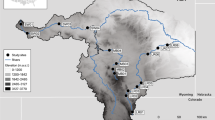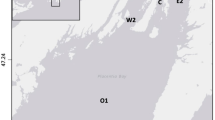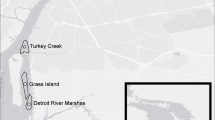Abstract
Mussels provide important ecological functions in freshwater ecosystems but the associations between Amazonian mussels, macroinvertebrate assemblage and habitat quality remain poorly understood. We investigated whether changes in macroinvertebrate assemblage structure and ecological functioning were associated with mussel presence. We compared sites with and without mussels, with similar habitat conditions, in an eastern Amazonian river, using field measurements of macroinvertebrate structure, hydrological variables and sediment organic matter, and laboratory experiments of mussel clearance rate and biodeposition. Sites with mussels were associated with higher macroinvertebrate abundance and number of taxa, especially for trichopterans Marilia (shredder), Oecetis (predator) and Antarctoecia (collector). Decreased chlorophyll-a in the water column and increased sediment organic matter were positively associated with mussel presence. Laboratory experiments corroborated these patterns, which were stronger with higher mussel density. Mussel filtration and biodeposition may be associated with habitat quality for other invertebrates by lowering phytoplankton density in the water column and increasing inputs of sediment organic matter. This suggests a potential role of freshwater mussels in ecosystem function associated with high taxonomic and functional diversity in the macroinvertebrate assemblages of an eastern Amazon river, enhancing the already high mussel conservation priority.




Similar content being viewed by others
Data availability
Data associated with this manuscript are available on Figshare (https://doi.org/10.6084/m9.figshare.14787813.v1)
References
Allen, D. C. & C. C. Vaughn, 2011. Density-dependent biodiversity effects on physical habitat modification by freshwater bivalves. Ecology 92: 1013–1019.
American Public Health Association, 1995. Standard Methods for the Examination of Eater and Wastewater. American Public Health Association, Washington, DC.
Atkinson, C. L. & C. C. Vaughn, 2015. Biogeochemical hotspots: temporal and spatial scaling of the impact of freshwater mussels on ecosystem function. Freshwater Biology 60: 563–574.
Atkinson, C. L., H. M. Halvorson, K. A. Kuehn, M. Winebarger, A. Hamid & M. N. Waters, 2021. Filter-feeders have differential bottom-up impacts on green and brown food webs. Oecologia 195: 187–198.
Atkinson, C. L., M. R. First, A. P. Covich, S. P. Opsahl & S. W. Golladay, 2011. Suspended material availability and filtration–biodeposition processes performed by a native and invasive bivalve species in streams. Hydrobiologia 667: 191–204.
Atkinson, C. L., J. F. Kelly & C. C. Vaughn, 2014. Tracing consumer-derived nitrogen in riverine food webs. Ecosystems 17: 485–496.
Benelli, S., M. Bartoli, M. Zilius, I. Vybernaite-Lubiene, T. Ruginis, D. Vaiciute, J. Petkuviene & E. A. Fano, 2019. Stoichiometry of regenerated nutrients differs between native and invasive freshwater mussels with implications for algal growth. Freshwater Biology 64: 619–631.
Bocard, D., F. Gillet & P. Legendre, 2011. Numerical Ecology with R. Springer, New York.
Boeker, C., T. Lueders, M. Mueller, J. Pander & J. Geist, 2016. Alteration of physico-chemical and microbial properties in freshwater substrates by burrowing invertebrates. Limnologica 59: 131–139.
Bódis, E., B. Tóth, J. Szekeres, P. Borza & R. Sousa, 2014. Empty native and invasive bivalve shells as benthic habitat modifiers in a large river. Limnologica 49: 1–9.
Braun, A., K. Auerswald & J. Geist, 2012. Drivers and spatiotemporal extent of hyporheic patch variation: implications for sampling. PLoS ONE 7: 1–10.
Bril, J. S., J. J. Durst, B. M. Hurley, C. L. Just & T. J. Newton, 2014. Sensor data as a measure of native freshwater mussel impact on nitrate formation and food digestion in continuous-flow mesocosms. Freshwater Science 33: 417–424.
Brooks, M. E., K. Kristensen, K. J. van Benthem, A. Magnusson, C. W. Berg, A. Nielsen, H. J. Skaug, M. Maechler & B. M. Bolker, 2017. glmmTMB: balances speed and flexibility among packages for zero-inflated generalized linear mixed modeling. The R Journal 9: 378–400.
Buelow, C. A. & N. J. Waltham, 2020. Restoring tropical coastal wetland water quality: ecosystem service provisioning by a native freshwater bivalve. Aquatic Sciences. https://doi.org/https://doi.org/10.1007/s00027-020-00747-7.
Coughlan, J., 1969. The estimation of filtering rate from the clearance of suspensions. Marine Biology 2: 356–358.
Douda, K. & Z. Čadková, 2018. Water clearance efficiency indicates potential filter-feeding interactions between invasive Sinanodonta woodiana and native freshwater mussels. Biological Invasions 20: 1093–1098.
Ferreira-Rodríguez, N., Y. B. Akiyama, O. V. Aksenova, R. Araujo, M. C. Barnhart, Y. V. Bespalaya, A. E. Bogan, I. N. Bolotov, P. B. Budha, C. Clavijo, S. J. Clearwater, G. Darrigran, V. T. Do, K. Douda, E. Froufe, C. Gum**er, L. Henrikson, C. L. Humphrey, N. A. Johnson, O. Klishko, M. W. Klunzinger, S. Kovitvadhi, U. Kovitvadhi, J. Lajtner, M. Lopes-Lima, E. A. Moorkens, S. Nagayama, K.-O. Nagel, M. Nakano, J. N. Negishi, P. Ondina, P. Oulasvirta, V. Prié, N. Riccardi, M. Rudzite, F. Sheldon, R. Sousa, D. L. Strayer, M. Takeuchi, J. Taskinen, A. Teixeira, J. S. Tiemann, M. Urbanska, S. Varandas, M. V. Vinarski, B. J. Wicklow, T. Zajac & C. C. Vaughn, 2019. Research priorities for freshwater mussel conservation assessment. Biological Conservation 231: 77–87.
Gordon, N. D., T. M. McMahon, B. L. Finlayson, C. J. Gippel & R. J. Nathan, 2004. Stream Hydrology: An Introduction for Ecologists. Wiley, Chichester.
Hamada, N., J. L. Nessimian & R. B. Querino, 2014. Insetos aquáticos na Amazônia Brasileira: Taxonomia, biologia e ecologia. Editora INPA, Manaus.
Holomuzki, J. R., J. W. Feminella & M. E. Power, 2010. Biotic interactions in freshwater benthic habitats. Journal of the North American Benthological Society 29: 220–244.
Hothorn, T., K. Hornik & A. Zeileis, 2006. Unbiased recursive partitioning: a conditional inference framework. Journal of Computational and Graphical Statistics 15: 651–674.
Howard, J. K. & K. M. Cuffey, 2006. The functional role of native freshwater mussels in the fluvial benthic environment. Freshwater Biology 51: 460–474.
Ilarri, M. I., L. Amorim, A. T. Souza & R. Sousa, 2018. Physical legacy of freshwater bivalves: effects of habitat complexity on the taxonomical and functional diversity of invertebrates. Science of the Total Environment 634: 1398–1405.
Junk, W. J., 1997. The Central Amazon floodplain. Springer, New York.
Lopes-Lima, M., L. E. Burlakova, A. Y. Karatayev, K. Mehler, M. Seddon & R. Sousa, 2018. Conservation of freshwater bivalves at the global scale: diversity, threats and research needs. Hydrobiologia 810: 1–14.
Lummer, E.-M., K. Auerswald & J. Geist, 2016. Fine sediment as environmental stressor affecting freshwater mussel behavior and ecosystem services. Science of the Total Environment 571: 1340–1348.
Moraes, B. C., J. M. N. Costa, A. C. L. Costa & M. Costa, 2005. Variação espacial e temporal da precipitação no Estado do Pará. Acta Amazônica 35: 207–214.
Morales, Y., L. J. Weber, A. E. Mynett & T. J. Newton, 2006. Effects of substrate and hydrodynamic conditions on the formation of mussel beds in a large river. Journal of the North American Benthological Society 25: 664–676.
Oksanen, J., F. G. Blanchet, R. Kindt, P. Legendre, P. R. Minchin, R. B. O’Hara, G. L. Simpson, P. Solymos, M. H. H. Stevens & H. Wagner, 2019. vegan: Community Ecology Package [available on internet at: http://CRAN.R-project.org/package=vegan].
Pereira, D., M. C. D. Mansur, L. D. S. Duarte, A. S. de Oliveira, D. M. Pimpão, C. T. Callil, C. Ituarte, E. Parada, S. Peredo, G. Darrigran, F. Scarabino, C. Clavijo, G. Lara, I. C. Miyahira, M. T. R. Rodriguez & C. Lasso, 2014. Bivalve distribution in hydrographic regions in South America: historical overview and conservation. Hydrobiologia 735: 15–44.
Pinheiro, J. C. & D. M. Bates, 2000. Mixed-Effects Models in S and S-PLUS. Springer, New York.
R Core Team, 2020. R: A Language and Environment for Statistical Computing. R Foundation for Statistical Computing, Vienna [available on internet at: http://www.R-project.org/].
Ramírez, A. & P. E. Gutiérrez-Fonseca, 2014. Functional feeding groups of aquatic insect families in Latin America: a critical analysis and review of existing literature. Revista de Biología Tropical 62: 155-167.
Richter, A., K. Stoeckl, M. Denic & J. Geist, 2016. Association between the occurrence of the thick-shelled river mussel (Unio crassus) and macroinvertebrate, microbial, and diatom communities. Freshwater Science 35: 922–933.
Simeone, D., C. Santos, F. Gisane, C. H. Tagliaro & C. R. Beasley, 2018. Greater macroinvertebrate diversity and freshwater mussel density in meander margins of an Amazon river. Freshwater Biology 63: 1118–1129.
Simeone, D., C. H. Tagliaro & C. R. Beasley, 2021. Amazonian freshwater mussel density: a useful indicator of macroinvertebrate assemblage and habitat quality. Ecological Indicators. https://doi.org/https://doi.org/10.1016/j.ecolind.2020.107300.
Spooner, D. E. & C. C. Vaughn, 2006. Context-dependent effects of freshwater mussels on stream benthic communities. Freshwater Biology 51: 1016–1024.
Spooner, D. E. & C. C. Vaughn, 2012. Species’ traits and environmental gradients interact to govern primary production in freshwater mussel communities. Oikos 121: 403–416.
Strayer, D. L., 2008. Freshwater Mussel Ecology: A Multifactor Approach to Distribution and Abundance. University of California Press, Los Angeles.
Strayer, D. L., 2014. Understanding how nutrient cycles and freshwater mussels (Unionoida) affect one another. Hydrobiologia 735: 277–292.
Tibshirani, R. & F. Leisch, 2019. bootstrap: Functions for the Book “An Introduction to the Bootstrap” [available on internet at: https://CRAN.R-project.org/package=bootstrap].
Tichý, L., 2016. Field test of canopy cover estimation by hemispherical photographs taken with a smartphone. Journal of Vegetation Science 27: 427–435.
Tuttle-Raycraft, S. & J. D. Ackerman, 2018. Does size matter? Particle size vs. quality in bivalve suspension feeding. Freshwater Biology 63: 1560–1568.
Vaughn, C. C., 2010. Biodiversity losses and ecosystem function in freshwaters: emerging conclusions and research directions. BioScience 60: 25–35.
Vaughn, C. C., 2018. Ecosystem services provided by freshwater mussels. Hydrobiologia 810: 15–27.
Vaughn, C. C. & C. C. Hakenkamp, 2001. The functional role of burrowing bivalves in freshwater ecosystems. Freshwater Biology 46: 1431–1446.
Vaughn, C. C. & D. E. Spooner, 2006. Unionid mussels influence macroinvertebrate assemblage structure in streams. Journal of the North American Benthological Society 25: 691–700.
Vaughn, C. C., K. B. Gido & D. E. Spooner, 2004. Ecosystem processes performed by unionid mussels in stream mesocosms: species roles and effects of abundance. Hydrobiologia 35: 35–47.
Vaughn, C. C., S. J. Nichols & D. E. Spooner, 2008. Community and foodweb ecology of freshwater mussels. Journal of the North American Benthological Society 27: 409–423.
Volkmer-Ribeiro, C., M. C. D. Mansur, D. Pereira, J. S. Tiemann, K. S. Cummings & M. H. Sabaj, 2019. Sponge and mollusk associations in a benthic filter-feeding assemblage in the middle and lower **ngu River, Brazil. Proceedings of the Academy of Natural Sciences of Philadelphia 166: 1–24.
Zieritz, A., F. N. Mahadzir, W. N. Chan & S. McGowan, 2019. Effects of mussels on nutrient cycling and bioseston in two contrasting tropical freshwater habitats. Hydrobiologia 835: 179–191.
Zieritz, A., W. N. Chan, S. McGowan & C. Gibbins, 2020. High rates of biodeposition and N-excretion indicate strong functional effects of mussels (Bivalvia: Unionida) in certain anthropogenic tropical freshwater habitats. Hydrobiologia. https://doi.org/https://doi.org/10.1007/s10750-020-04464-y.
Zuur, A. F., E. N. Ieno, N. J. Walker, A. A. Savaliev & G. M. Smith, 2009. Mixed Effects Models and Extensions in Ecology with R. Springer, New York.
Acknowledgements
This work was carried out as a part of DS’s Ph.D. degree in Environmental Biology, Universidade Federal do Pará (UFPA). DS thanks the Coordenação de Aperfeiçoamento de Pessoal de Nível Superior (CAPES) for a postgraduate scholarship and the Programa de Pós-Graduação em Biologia Ambiental at UFPA for logistic support. We are grateful to Ádila Kelly Rodrigues da Costa (UFPA) for help with the chlorophyll-a analysis. We also thank Jaqueline Feitosa, Jeovana Lima and Lilian Amorim (UFPA) for help with the laboratory experiments and the people of the Arimbu and Mocajuba settlements on the Caeté River for their kind assistance. Fieldwork was carried out under License 21187-1 from the Instituto Chico Mendes de Conservação da Biodiversidade – ICMBio.
Funding
Not applicable.
Author information
Authors and Affiliations
Corresponding author
Ethics declarations
Conflict of interest
The authors declare that they have no conflict of interest.
Additional information
Handling editor: María del Mar Sánchez-Montoya
Publisher's Note
Springer Nature remains neutral with regard to jurisdictional claims in published maps and institutional affiliations.
Supplementary Information
Below is the link to the electronic supplementary material.
Rights and permissions
About this article
Cite this article
Simeone, D., Tagliaro, C.H. & Beasley, C.R. Filter and deposit: a potential role of freshwater mussels in ecosystem functioning associated with enhanced macroinvertebrate assemblage structure in a Neotropical river. Hydrobiologia 848, 4211–4223 (2021). https://doi.org/10.1007/s10750-021-04633-7
Received:
Revised:
Accepted:
Published:
Issue Date:
DOI: https://doi.org/10.1007/s10750-021-04633-7




